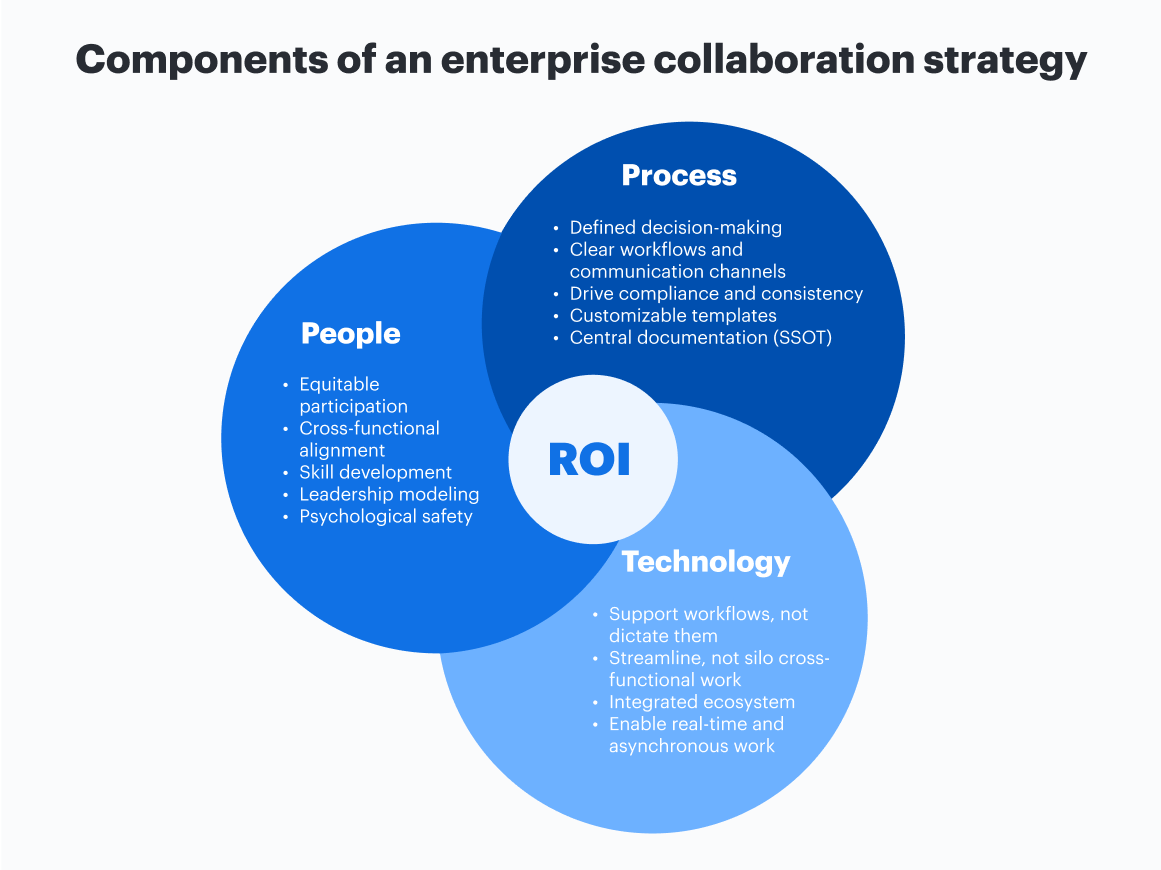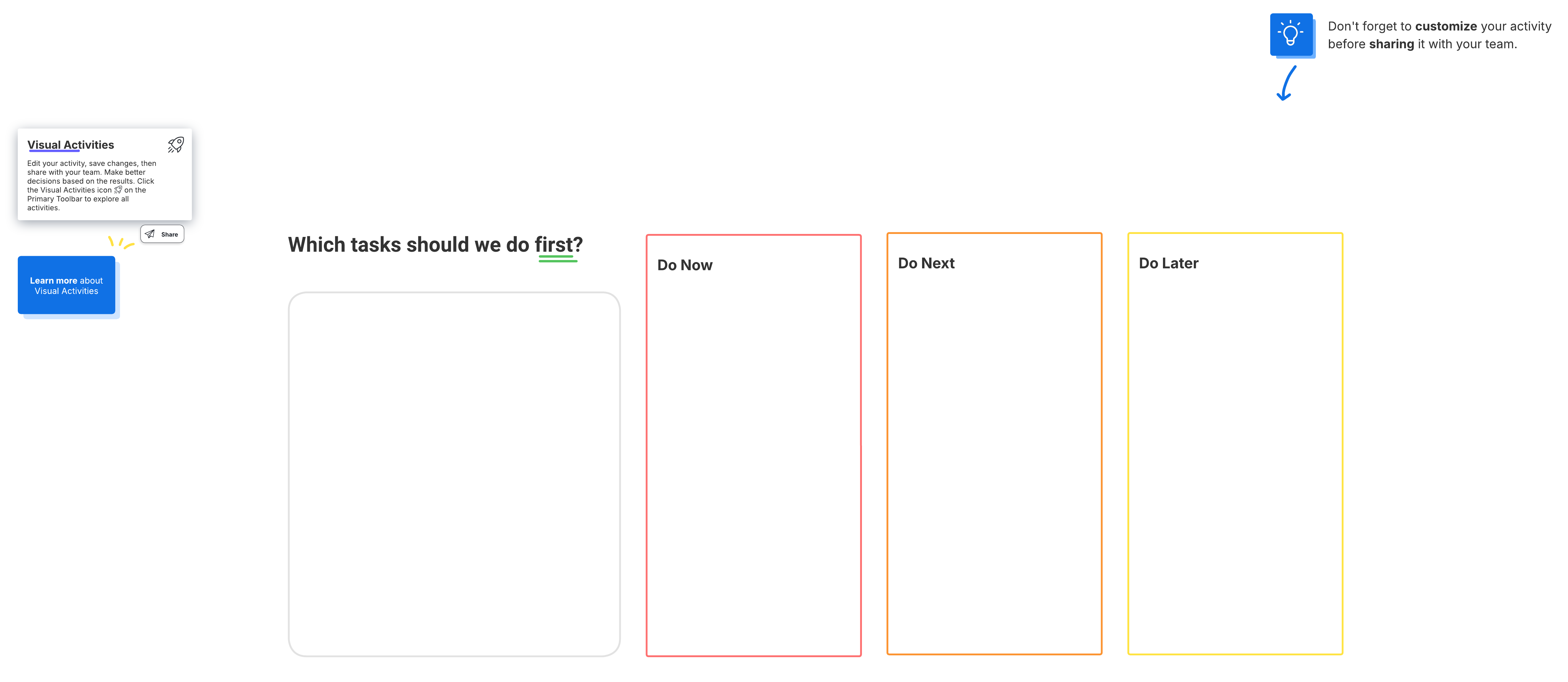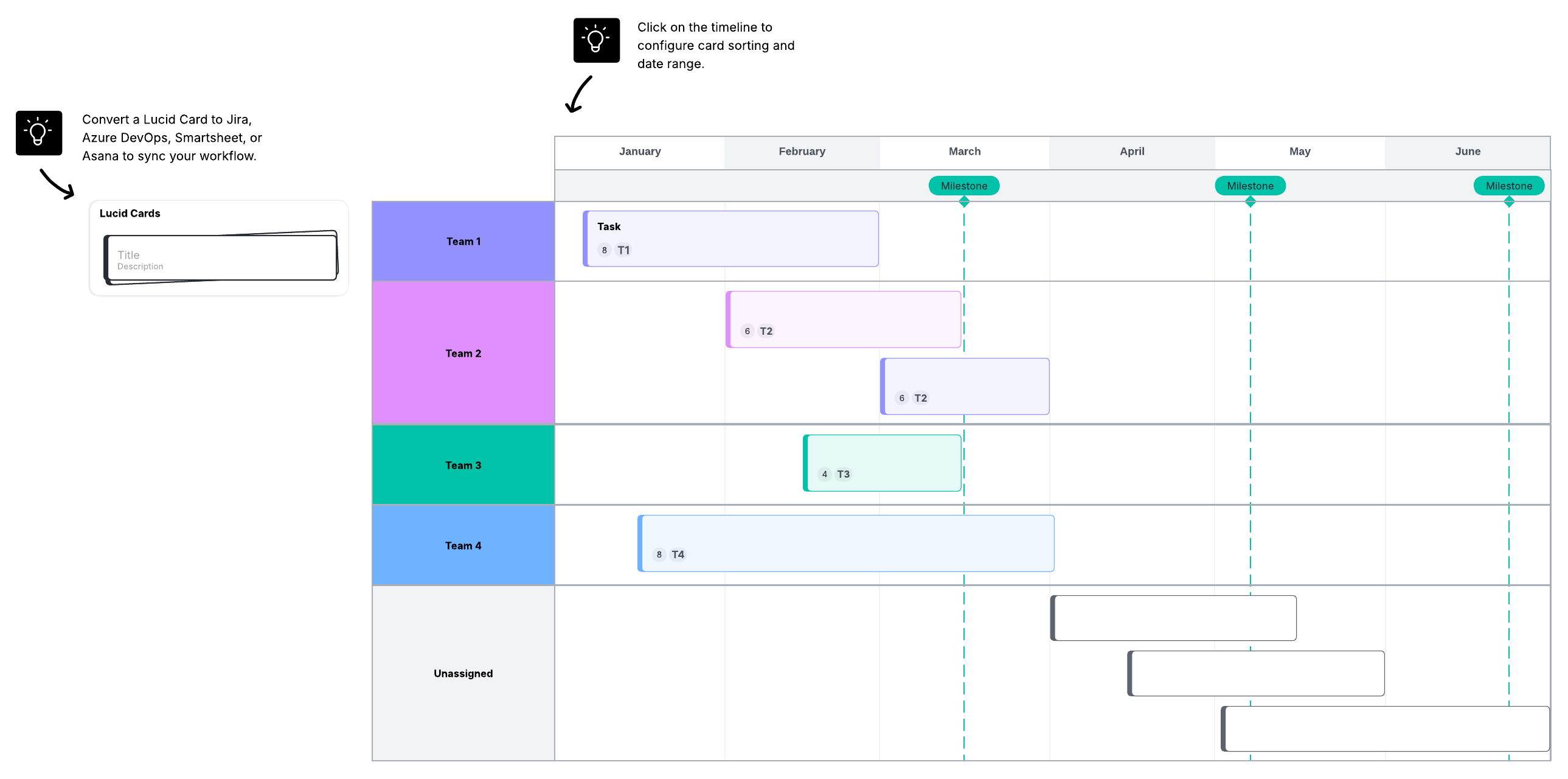
[Guide] How to build an enterprise collaboration strategy that accelerates business goals
Reading time: about 13 min
A new collaboration tool here, a new process or policy there—and ROI nowhere to be found.
Why? Even if your organization experiences some improvement from these ad-hoc efforts, it’s nearly impossible to know how to replicate, scale, and maximize success without a defined enterprise collaboration strategy.
There was a time when this approach (or lack thereof) could more or less suffice. Today, that’s simply not the case.
The phrase “fast-paced work environment” has become so commonplace that it doesn’t seem any other type of work even exists anymore. We won’t belabor this point, but we do know that it’s hard to keep pace with AI advancements or changing work conditions if you don’t have an intentional plan for enabling collaboration. And given how important collaboration is to helping a business achieve, well, pretty much anything, there’s far too much risk in leaving it up to chance.
If you’re ready to turn your ad hoc collaboration efforts into a clearly defined collaboration strategy that yields real returns, you’re in the right place. Our professional services team at Lucid has worked with countless businesses over the years, seeing firsthand what works and what doesn’t. We’re now distilling this experience into a guide to help your business create its own enterprise collaboration strategy that accelerates your business goals, whatever those may be.
What is an enterprise collaboration strategy?
Strategies for parts of the business (like marketing and operations) are well-understood today, but a strategy for enterprise collaboration? Most people don’t know what to picture when they hear it.
Lucid offers the following definition:
An enterprise collaboration strategy is a deliberate plan for how people communicate, share knowledge, and make decisions across the organization. It aligns principles, practices, and platforms to ensure collaboration is consistent, intentional, and scalable.
Let’s break this down even more. A collaboration strategy should include a clear vision for what you’re hoping to achieve, defined tactics and implementation timelines for how you’ll achieve it, and metrics that will let you know how successful your tactics are (so you can confidently report ROI and refine your strategy).
“An enterprise collaboration strategy is the operating system for how work gets done—turning collaboration from a chaotic byproduct into a competitive advantage.”
—Jeff Rosenbaugh, senior director of professional services, Lucid
Key components of an enterprise collaboration strategy
Although the concept of an enterprise collaboration strategy may be new, you can build one using a familiar framework: the “People, Process, Technology” (PPT) framework.
The PPT framework helps organizations look at collaboration holistically rather than falling into the common trap of focusing solely on technology. When organizations overemphasize the technology aspect, they often make purchasing decisions from a narrow cost-cutting lens, which, ironically, leads to underutilized tools that end up costing more in the long haul.
“If you don't have a clear strategy, you end up measuring things like cost of product, and you may decide to bring in a cheaper product without considering why you need the product in the first place.”
—Christopher Bailey, director of professional services, Lucid
Consider this: People without process = collaboration chaos and inconsistency. Process without people = compliance theater. And technology without people or process = shelfware.
But a collaboration strategy that considers how people, processes, and technology work together results in business acceleration. That’s an equation we can feel good about.

5 steps to building an enterprise collaboration strategy
How can you actually use the PPT framework to build an enterprise collaboration strategy? We’ve broken the process down into five steps to guide your efforts.

Step 1: Set the vision for your strategy
Start by getting crystal clear on what you are trying to accomplish with a collaboration strategy. “You can think of your vision as establishing what ‘good’ collaboration looks like for your business,” said Bailey. “Define what behaviors and outcomes—such as faster decision-making—you’d expect to see.”
As you’re establishing your vision, consider:
-
Where do you want information to flow? How should teams access information?
-
What standards should teams follow across the organization, and where will teams innovate?
-
Where would you want to see cross-functional collaboration? Which teams should be working together frequently? Is there anywhere you’d want intentional silos?
-
Where do you want fast decision-making, and where do you want slower, more researched decision-making?
-
How will remote and in-person teams stay engaged and aligned?
Here’s an example of a vision for a hybrid software company:
We aim to create a unified collaboration experience that bridges time zones, tools, and teams so that every employee can contribute fully—wherever they work—enabling the organization to respond to market changes and capitalize on new opportunities faster.
Step 2: Assess your enterprise collaboration strengths and weaknesses
Your vision represents your ideal future state of collaboration. Now, it’s time to assess your organization’s current state of collaboration and see how close—or far off—it is from your vision.
You’ll want to evaluate what’s working well and where you have gaps. Gathering a mix of both quantitative and qualitative evidence is key here. When you can, try to evaluate the frequency of certain events (e.g., 25% of meetings are recurring) or the amount of time certain actions take (e.g., teams spend an average of five hours/week looking for project information). These evaluations will give you benchmarks that you can use later to measure improvements.
To help kick-start your assessment, we’ve put together a list of sample questions for each component of your strategy (be sure to customize and add your own!):
People:
-
Do team members feel empowered to contribute? How comfortable are individuals in sharing dissenting opinions?
-
Do team members understand how their work ties into the larger business goals?
-
How long do teams spend trying to get aligned on project goals or status?
-
If you have hybrid teams, do in-person and remote teams feel connected? How are they currently connecting?
Process:
-
How often are teams recreating processes?
-
How do different stakeholders get project updates?
-
How do cross-functional teams work together?
-
How are different types of decisions made?
Pro tip: Visualize your processes—both current and ideal future state—to better understand gaps, roadblocks, and inefficiencies.
Technology:
-
How long does it currently take teams to find relevant project information?
-
What collaboration tools are teams in different departments using? What challenges or benefits do each of these pose?
-
Do your collaboration tools support effective real-time collaboration? What about asynchronous collaboration?
As you complete this assessment, it’s important to seek feedback from teams across the business: Never assume you know the answer. You may consider sending out anonymous surveys to different teams or engaging with a professional services team that can conduct the assessment and recommend tactical improvements for you.

Collaboration health assessment tool
We’ve compiled our observations over the years into a self-assessment template you can use to evaluate your organization’s collaboration strengths and weaknesses.
Try it outStep 3: Make the plan: How will you achieve your vision?
With a clear understanding of your current state and how that compares to your vision, you’re well on your way to building an action plan. Of course, specific action items will be unique to your organization, but we’ve put together a few tips for each component to inspire your plan.

Need help improving the people aspect of your strategy? Here are a few ideas to get you started:
-
Try leadership modeling—that is, have leaders across the organization model the collaborative behaviors you want to see. For example, you may encourage leaders to “work out loud” by frequently communicating progress, insights, and challenges in shared channels for transparency.
-
Align incentives around team success versus a “winner takes all” reward system. Reinforce collaborative behaviors through recognition and repetition.
-
Build rituals that encourage collaboration, such as regular “jam sessions” for teams to share ideas or daily standups for teams to touch base on progress.
-
Provide resources and training to help teams improve their collaboration skills.
-
Take steps to intentionally foster collaboration equity. For example, you may look to enable asynchronous collaboration to accommodate team members in different time zones or with different working styles.
Need help improving the process aspect of your strategy? Try out these recommendations:
-
Create a single source of truth (SSOT) to eliminate ambiguity around where to find information. The most effective SSOTs tend to be cloud-based (to avoid versioning issues), visual (to increase comprehension), dynamic (to stay up to date), and connected with other tools (to reduce context switching).
-
Map out approval flows and where you’ll keep and store different types of content to ensure compliance.
-
Standardize common workflows with reusable templates. For example, if multiple teams are running Agile events, share customizable templates for daily standups, sprint planning, retrospectives, and more.
-
Leave room for innovation. Standardize org-wide processes where you can, but encourage individual teams to define and iterate on their own processes.
“You have to be careful with attempting to be exhaustive. Standardize core organization-wide workflows, but then let the organization naturally update their processes and practices to match your vision.”
—Christopher Bailey, director of professional services, Lucid
Need help improving the technology aspect of your strategy? We’ve put together a few suggestions, but before getting into those, make sure you have process alignment first. Tools should serve the workflows, not dictate them. With that in mind, try out these ideas:
-
Establish primary tool standards for key work modes—brainstorming, planning, execution, or asynchronous collaboration—but be cautious of segmenting tools by department. When leaders assign tools to teams, they can unintentionally fragment cross-functional work, slowing down collaboration and increasing the chance of shadow IT as teams search for workarounds.
-
Create an ecosystem of tools that support the desired cross-functional behaviors. When evaluating technology, consider interoperability—that is, how each tool overlaps or integrates with the others. If you only examine each tool individually, you could unintentionally break the system.
-
Look for places where you can consolidate tools. “When collaboration feels broken, it’s rarely about needing more tools,” said Rosenbaugh. “It’s about needing a strategy to unify the ones you already have.”
-
Make sure you can clearly align any new tool with a clear business opportunity. Try the technology value mapping template to guide your decisions.
“You can’t architect collaboration the way you architect an IT network. Real collaboration flows across tools, teams, and functions. Any strategy that ignores that will collapse under its own rigidity.”
—Jeff Rosenbaugh, senior director of professional services, Lucid

Considerations for building your collaboration tech stack
Read more on how to align your collaboration technology with the rest of your strategy.
Learn moreStep 4: Run pilot programs to test your strategy
You've envisioned your future state, compared it to your current state, and identified the steps you can take to close the gaps between the two. It’s now time to put your plan in place—but not all at once.
Instead of a full-scale rollout, we recommend testing components of your strategy at a time. Even the best strategies are built on assumptions—about how people will work, how tools will fit into workflows, and how change will be received. A pilot lets you test those assumptions and collect data, both qualitative and quantitative, to validate which ideas are worth putting time and resources into.
“Big rollouts without validation are high-risk bets,” said Rosenbaugh. “Start small, learn fast, then scale what sticks.”
An effective pilot program should include specific activities, a defined timeline, and measurable outcomes, including:
-
Time: How long does an activity take now versus before?
-
Cost: Did the pilot program result in new revenues or cost avoidance?
-
Efficiency: Do people say, when interviewed, that they're more efficient than before?
You may also wish to find volunteer teams who are excited to try new collaboration tactics or designate facilitators to oversee different tests.
Let’s take a look at an example of a collaboration strategy pilot program. Maybe your assessment revealed that over half of meetings don’t end in clear, actionable next steps. In this case, your goal is to test ways to increase the percentage of meetings that are actionable. You could identify teams or seek volunteers to experiment with using a visual, digital space to record agenda items, questions, and action items in each meeting over the course of three months. Throughout this time, you can ask the teams to report on improvements and capture feedback on how they’ve used the tool most effectively.

Here are a few other examples of ways to pilot your collaboration strategy:
-
Reduce the amount of time teams spend searching for project information by inviting a cross-functional team to create a single source of truth for all project-related information.
-
Cut down on the time in meetings by inviting teams to pick a few recurring meetings to take asynchronously and record results.
-
Increase the number of collaborators who contribute in brainstorming meetings by having a few teams pilot a visual whiteboard versus relying on verbal ideation.
“Pilots turn strategy from theory into practice—and from ideas to outcomes.”
—Jeff Rosenbaugh, senior director of professional services, Lucid
Step 5: Refine and scale your strategy
As you see success with your pilot programs, you can start scaling those activities across other parts of the business. This part can be challenging—after all, not everyone will be receptive to change. Here, we recommend pulling from our change management playbook to ease the transition.
Try:
-
Appealing to human needs, not commanding change. Be clear on how the new collaboration tactics will benefit the people, improve work-life balance, or solve common day-to-day challenges (who wouldn’t be excited to hear of a way to cut back on meetings?).
-
Share wins from your pilot programs widely. Early success stories not only create momentum, but they also help teams see tangible examples of ways they could improve their work as well.
-
Start to standardize what works. Sharing out templates for anything from prioritizing work to getting stakeholder feedback can make it easier for teams to adopt new processes.
-
Provide ongoing support. It’s actually rather difficult to communicate too much during change. Share your goals and outcomes frequently—in company-wide Slack channels, all-hands meetings, and team-level touchpoints.
-
Seek regular feedback. Your first attempt may not be the best approach, and that’s okay. They’ll get better when you regularly check in on team sentiment and seek ideas from those in the weeds.
-
Establish a center of excellence (CoE) to ensure continuous improvement. “Once your strategy is in place, a center of excellence can bring individuals together across the business dedicated to regularly sharing best practices and driving intentional, sustainable collaboration across the organization,” said Bailey.
Get help building your collaboration strategy from the experts
At this point, you should have a clear idea of how to not only measure ROI on your collaboration strategy but also improve ROI.
If you’re looking to accelerate time to value with your collaboration strategy, Lucid—and Lucid’s professional services team—can help. Lucid has recently added three powerful accelerators (Agile Accelerator, Cloud Accelerator, and Process Accelerator) to our leading Visual Collaboration Suite to help collaboration leaders standardize processes, scale effective practices, and increase transparency for everyone.
Whether you need support in assessing your enterprise collaboration posture, building custom templates, or providing team training, our professional services experts are ready to help you maximize collaboration ROI.

Build your strategy
Get in touch with us to learn how Lucid can help you improve enterprise collaboration and accelerate work.
Contact usAbout Lucid
Lucid Software is a pioneer and leader in visual collaboration dedicated to helping teams build the future. With its products—Lucidchart, Lucidspark, and Lucidscale—teams are supported from ideation to execution and are empowered to align around a shared vision, clarify complexity, and collaborate visually, no matter where they are. Lucid is proud to serve top businesses around the world, including customers such as Google, GE, and NBC Universal, and 99% of the Fortune 500. Lucid partners with industry leaders, including Google, Atlassian, and Microsoft. Since its founding, Lucid has received numerous awards for its products, business, and workplace culture. For more information, visit lucid.co.
Related articles
Digital collaboration reimagined: A new approach for aligning teams
Whether your teams are in-office, remote, or hybrid, learn why digital-first collaboration is the key to alignment.
Collaboration technology guide: How to build a tech stack that accelerates work
Evaluating collaboration technology? Explore examples and get tips for choosing workplace collaboration tools that support your business goals.
[Guide] How to set up your hybrid workplace to maximize collaboration
Every team is a hybrid team. Learn how to set up your hybrid workplace with the right office design and culture to maximize collaboration.
How to use a collaboration assessment to evaluate and improve your team’s collaboration
Learn how to use a collaboration assessment tool for your team as we walk you through five key areas of collaboration.
